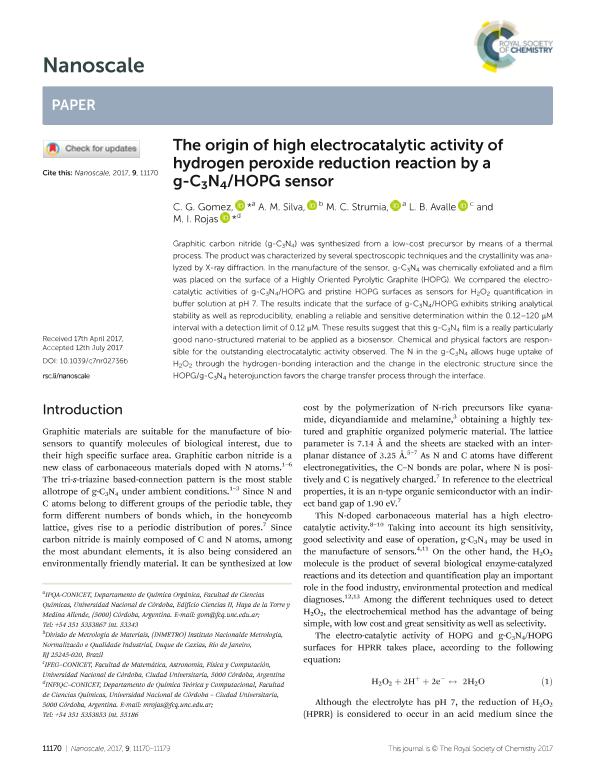Mostrar el registro sencillo del ítem
dc.contributor.author
Gomez, Cesar Gerardo

dc.contributor.author
Silva, Alexander Martins

dc.contributor.author
Strumia, Miriam Cristina

dc.contributor.author
Avalle, Lucia Bernardita

dc.contributor.author
Rojas, Mariana Isabel

dc.date.available
2018-11-15T17:44:25Z
dc.date.issued
2017-08
dc.identifier.citation
Gomez, Cesar Gerardo; Silva, Alexander Martins; Strumia, Miriam Cristina; Avalle, Lucia Bernardita; Rojas, Mariana Isabel; The origin of high electrocatalytic activity of hydrogen peroxide reduction reaction by a g-C3N4/HOPG sensor; Royal Society of Chemistry; Nanoscale; 9; 31; 8-2017; 11170-11179
dc.identifier.issn
2040-3372
dc.identifier.uri
http://hdl.handle.net/11336/64553
dc.description.abstract
Graphitic carbon nitride (g-C3N4) was synthesized from a low-cost precursor by means of a thermal process. The product was characterized by several spectroscopic techniques and the crystallinity was analyzed by X-ray diffraction. In the manufacture of the sensor, g-C3N4 was chemically exfoliated and a film was placed on the surface of a Highly Oriented Pyrolytic Graphite (HOPG). We compared the electrocatalytic activities of g-C3N4/HOPG and pristine HOPG surfaces as sensors for H2O2 quantification in buffer solution at pH 7. The results indicate that the surface of g-C3N4/HOPG exhibits striking analytical stability as well as reproducibility, enabling a reliable and sensitive determination within the 0.12-120 μM interval with a detection limit of 0.12 μM. These results suggest that this g-C3N4 film is a really particularly good nano-structured material to be applied as a biosensor. Chemical and physical factors are responsible for the outstanding electrocatalytic activity observed. The N in the g-C3N4 allows huge uptake of H2O2 through the hydrogen-bonding interaction and the change in the electronic structure since the HOPG/g-C3N4 heterojunction favors the charge transfer process through the interface.
dc.format
application/pdf
dc.language.iso
eng
dc.publisher
Royal Society of Chemistry

dc.rights
info:eu-repo/semantics/openAccess
dc.rights.uri
https://creativecommons.org/licenses/by-nc-sa/2.5/ar/
dc.subject
Hopg
dc.subject
G-C3n4
dc.subject
Electrocatalisis
dc.subject.classification
Otras Ciencias Químicas

dc.subject.classification
Ciencias Químicas

dc.subject.classification
CIENCIAS NATURALES Y EXACTAS

dc.title
The origin of high electrocatalytic activity of hydrogen peroxide reduction reaction by a g-C3N4/HOPG sensor
dc.type
info:eu-repo/semantics/article
dc.type
info:ar-repo/semantics/artículo
dc.type
info:eu-repo/semantics/publishedVersion
dc.date.updated
2018-10-22T19:38:22Z
dc.journal.volume
9
dc.journal.number
31
dc.journal.pagination
11170-11179
dc.journal.pais
Alemania

dc.journal.ciudad
Berlin
dc.description.fil
Fil: Gomez, Cesar Gerardo. Universidad Nacional de Córdoba. Instituto de Investigación y Desarrollo en Ingeniería de Procesos y Química Aplicada. Consejo Nacional de Investigaciones Científicas y Técnicas. Centro Científico Tecnológico Conicet - Córdoba. Instituto de Investigación y Desarrollo en Ingeniería de Procesos y Química Aplicada; Argentina
dc.description.fil
Fil: Silva, Alexander Martins. Instituto Nacionalde Metrologia; Brasil
dc.description.fil
Fil: Strumia, Miriam Cristina. Universidad Nacional de Córdoba. Instituto de Investigación y Desarrollo en Ingeniería de Procesos y Química Aplicada. Consejo Nacional de Investigaciones Científicas y Técnicas. Centro Científico Tecnológico Conicet - Córdoba. Instituto de Investigación y Desarrollo en Ingeniería de Procesos y Química Aplicada; Argentina
dc.description.fil
Fil: Avalle, Lucia Bernardita. Consejo Nacional de Investigaciones Científicas y Técnicas. Centro Científico Tecnológico Conicet - Córdoba. Instituto de Física Enrique Gaviola. Universidad Nacional de Córdoba. Instituto de Física Enrique Gaviola; Argentina
dc.description.fil
Fil: Rojas, Mariana Isabel. Consejo Nacional de Investigaciones Científicas y Técnicas. Centro Científico Tecnológico Conicet - Córdoba. Instituto de Investigaciones en Físico-química de Córdoba. Universidad Nacional de Córdoba. Facultad de Ciencias Químicas. Instituto de Investigaciones en Físico-química de Córdoba; Argentina
dc.journal.title
Nanoscale
dc.relation.alternativeid
info:eu-repo/semantics/altIdentifier/doi/https://dx.doi.org/10.1039/C7NR02736B
dc.relation.alternativeid
info:eu-repo/semantics/altIdentifier/url/https://pubs.rsc.org/en/Content/ArticleLanding/2017/NR/C7NR02736B
Archivos asociados
